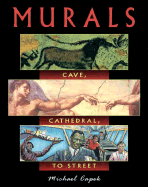
Murals: Cave, Cathedral, to Street By Micheal Capek Lerner Publications 1996
What I like about this book is that it makes the linkages
that are promised by the title by taking on an expanded definition of what
constitutes a mural. . Typically mural books are compartmentalized. Mural books
usually focus on contemporary urban murals, often with a nod in the direction
of classic Mexican murals. Other forms of painting that can be considered
murals are usually categorized differently.
However, if you define a mural as a large painting that is
done on a wall, and you look through history, you can find many examples of
murals. The Sistine Chapel, Mayan frescos, cave paintings, and Egyptian tomb
art would all fall under this definition. Usually these examples would not be
considered in relation to contemporary murals because they fall under different
disciplines. The book further expands upon this by considering some examples of
mosaics under its rubric.
The book starts with contemporary murals, and then it
stretches into the past to link the art form with earlier analogs such as
historical murals in the US, Mexican murals, Italian Renaissance Murals,
Ancient Roman & Egyptian wall art, and cave paintings.
I am quite fond of the very striking piece on that appears page
52. For me, it sums up what this book is about. The painting in question is “The
Fall of the Giants”, which was painted by Giulio Romano
from 1532-1534. It is simply a triumph of the imagination that shares many of
the sensibilities of modern urban mural art and wild style graffiti in an Italian
Renaissance framework. It simply transcends the boundaries of time and space.
No comments:
Post a Comment
Note: Only a member of this blog may post a comment.